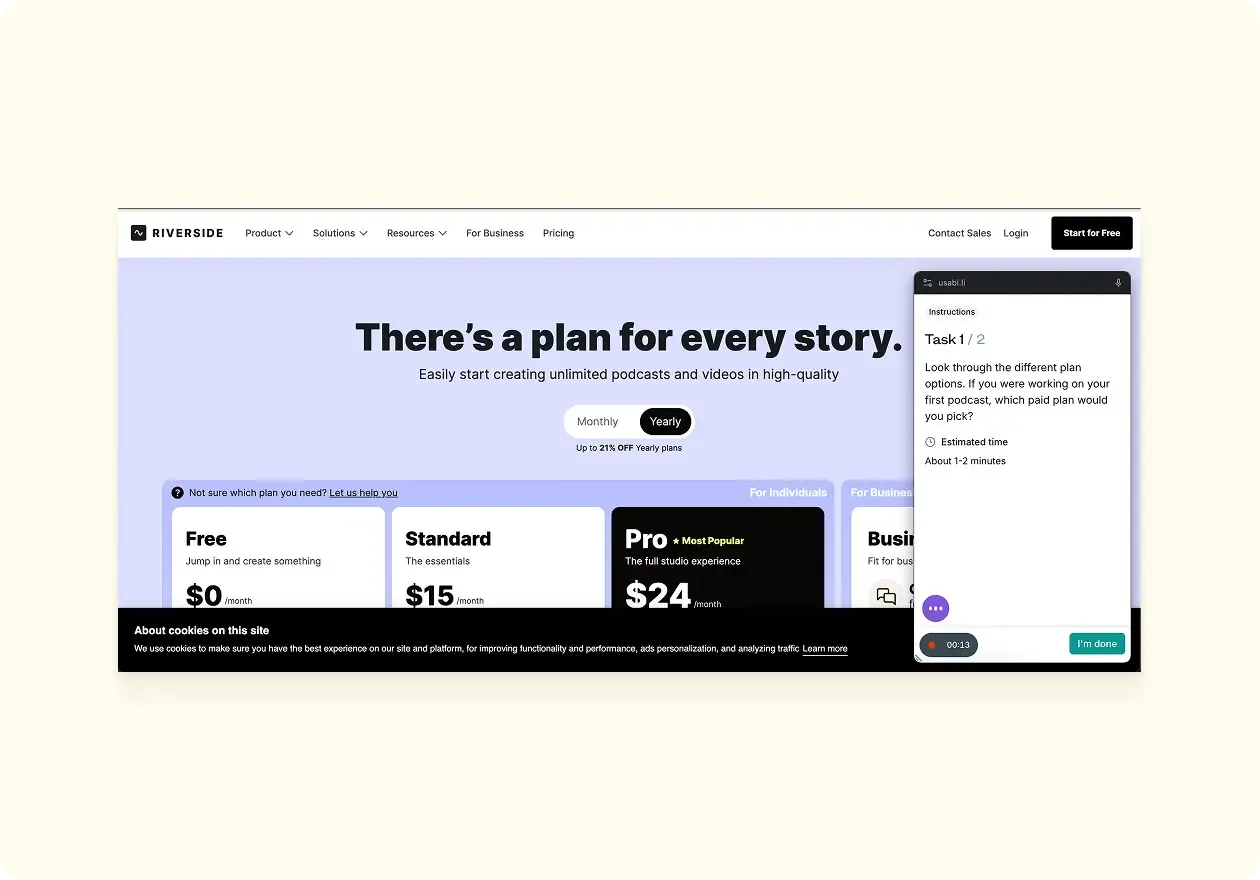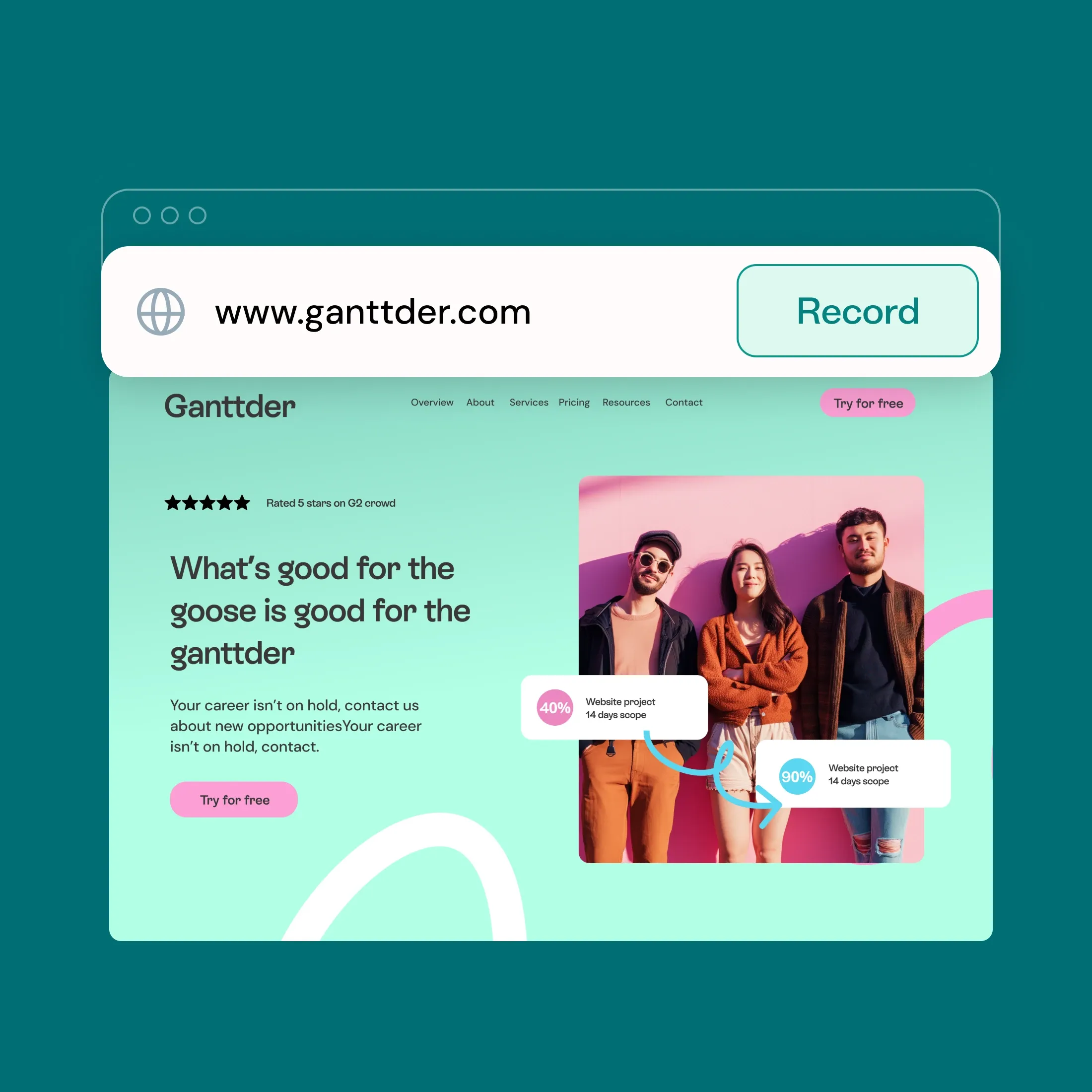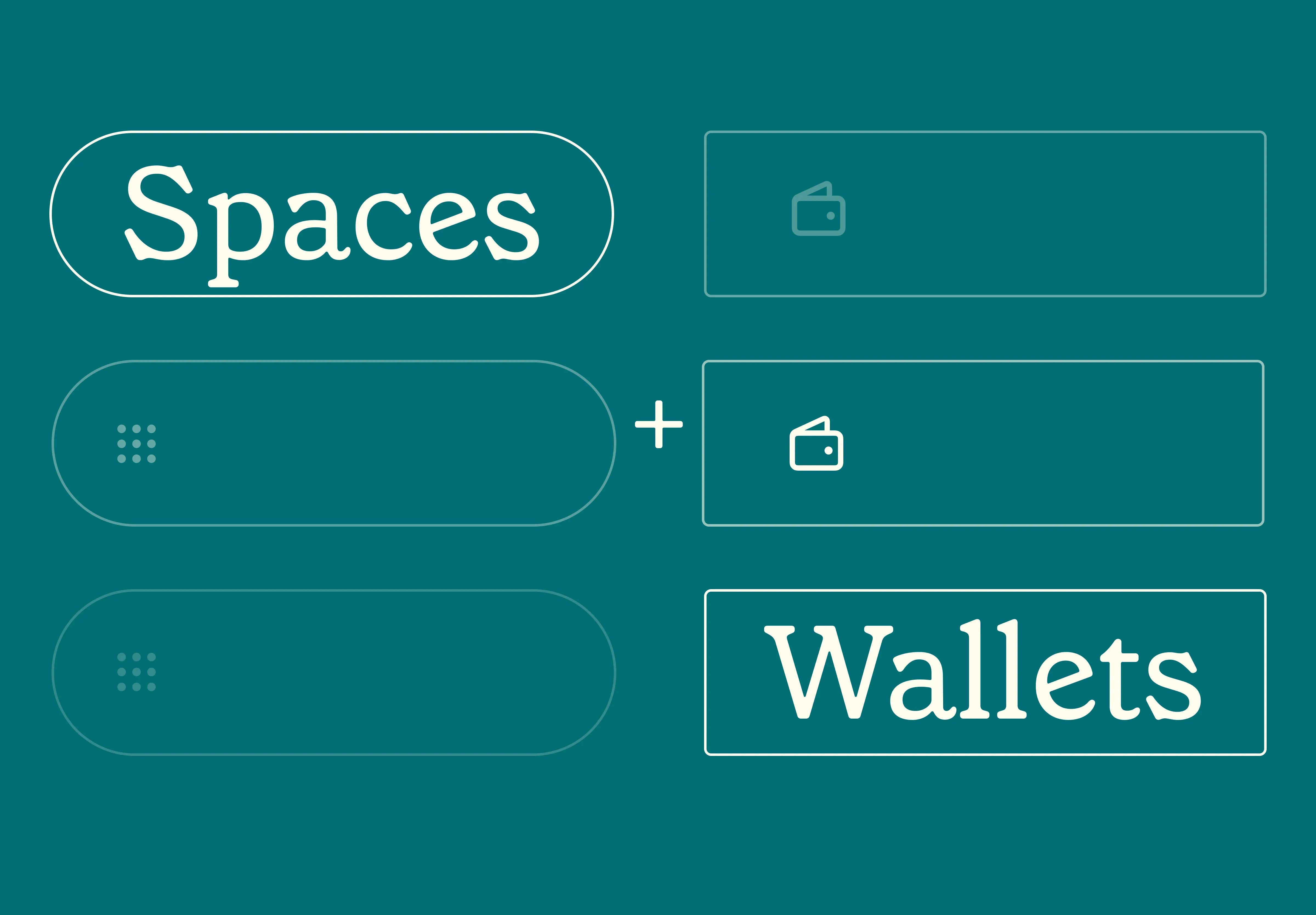10 Jul 2025
|15 min
Pricing research
Learn how effective pricing research can maximize your profits by finding the optimal price for your product. Discover the best frameworks and methodologies for success.

What if you could turn one of business's biggest guessing games into a strategic advantage? Pricing research helps you discover exactly what your customers are willing to pay, transforming pricing decisions from stressful guesswork into confident, data-driven choices.
This comprehensive guide covers essential pricing research methods, techniques, and competitive analysis strategies to help you develop an evidence-based pricing strategy that drives growth.
What is pricing research?
Pricing research is the process of gathering and analyzing data to find the best price for a product or service. It involves understanding consumer behavior, market trends, and competitive pricing to maximize profitability and market share.
When conducted effectively, it removes the need for guesswork from the all-important question of pricing, instead providing actionable, quantitative data derived from your target audience.

The importance of pricing research
Obviously, having a great product is key to success. But setting that product at the perfect price point can help your business in a few key ways. Pricing research can help:
Maximize profitability: Reach the highest possible profit margins while remaining attractive to consumers.
Enhance a competitive edge: Help understand how your competitors price their products and how they position themselves in the market.
Understand customer perception: Earn valuable insights into how customers view your product and brand, so you can align with them.
Enter the market: Find the best price point for entering new markets – such as new regions or industries – and launching new products or services.
Avoid undervaluation: Avoid underpricing in a way that devalues your brand.
Adapt to changes: Pivot swiftly in response to shifts in demand or changing market conditions.
Test your pricing strategy
Ready to move beyond pricing guesswork? Test different price points with real users using Lyssna's research tools. Start free today!
Market research pricing
Understanding the cost and value of market research for pricing decisions is crucial if your business is looking to optimize its pricing strategies. Market research pricing encompasses both the investment required to conduct pricing research and the methodologies used to determine optimal price points.

Market research vs pricing research: Understanding the difference
While often used interchangeably, market research and pricing research serve different purposes. Market research takes a broader view, examining overall market trends, consumer behavior, and competitive landscapes. Pricing research, meanwhile, focuses specifically on determining the optimal price points for your products or services.
Market research typically answers questions like "Who are our target customers?" and "What is the current market size?" In contrast, pricing research addresses more specific questions such as "What price will maximize our revenue?" and "How price-sensitive are our customers?"
The key difference lies in scope and application. Market research informs strategic decisions about market entry, positioning, and competitive advantage, while pricing research directly impacts revenue optimization and profitability. Both types of research are complementary and often work together to provide a comprehensive understanding of market dynamics.

Pricing research methods
A few frameworks have emerged over the years to help businesses research pricing. Each has their own pros and cons, which should be weighed given your particular use case.
Van Westendorp Price Sensitivity Meter
The Van Westendorp Price Sensitivity Meter (or PSM) measures how consumers feel about your product at particular price points. It’s easy to understand and use, and results in a very actionable pricing range for your product.
To use the meter, ask users four questions:
Too expensive: At what price would you consider the product to be so expensive that you wouldn't consider buying it?
Too cheap: At what price would you consider the product to be priced so low that you would feel the quality couldn’t be very good?
Expensive/high side: At what price would you consider the product to be expensive, but still worth buying?
Cheap/good value: At what price would you consider the product to be a bargain – a great buy for the money?
Then, after plotting responses on a chart, where the y-axis represents the percentage of respondents and the x-axis represents the dollar amounts indicated, you can create a range:
The lower limit of your price range is the intersection of the “too inexpensive” line and the “expensive/high side” line.
The upper limit of your price range is the intersection of the “too expensive” line and the “cheap/good value” line.
The optimal price point is the intersection of the “too expensive” line and the “too cheap” line.
The price sensitivity meter is easy to use and shows you different prices and suggested best prices. However, it's very subjective and doesn't have any background information, like market competition, production costs, and specific use-case scenarios.

Gabor-Granger method
The Gabor-Granger method is a pricing research technique that presents people with a series of different price points to determine their likelihood of purchasing at each price.
First, you ask if they’d buy the product for, say, $20. Then, if they said yes, you might if they’d buy it for $25. If they said no, you might ask if they’d buy it for $15. This continues throughout the acceptable price ranges to create data about the price point at which consumers will likely buy your product.
The Gabor-Granger method is useful when you want to maximize revenue and profit, as it actively scales toward the high end of where consumers would purchase. It’s also fairly easy to pull off: it doesn’t need to be structured meticulously, as it works in a logical sequence. However, as with the PSM, it lacks context, including product features, cost structures, and market conditions.
Conjoint analysis
Conjoint analysis is a double-edged sword: highly accurate, but complex to pull off adequately. It evaluates consumer preferences by presenting them with multiple product scenarios, each combining different combinations of attributes and price points.
The process by which these combinations are found is called discrete choice modeling. It reduces the many possible variables that could affect pricing to a series of discrete choices that you can test with consumers.
This method is best understood via a hypothetical scenario. Let’s say you’ve created a new type of productivity software. You’re curious about a few variables: monthly pricing, storage capacity, and customer support. These attributes could then be combined in a variety of configurations.
One customer might be asked which of the following options they'd purchase:
Option | Price | Storage | Customer Support |
|---|---|---|---|
1 | $20/month | 100 GB | Basic |
2 | $10/month | 50 GB | Basic |
3 | $30/month | 200 GB | Deluxe |
None of the above | n/a | n/a | n/a |
The next customer would get a different configuration. Through repetition, you may find that pricing is the most important attribute, with a strong preference for the $20/month price point.
Conjoint analysis provides detailed insights and a rich understanding of the trade-offs consumers are likely to make. However, it’s complex to design, implement, and analyze.

Monadic pricing
For monadic pricing research, you first split your respondents into different groups and then show each one a different price for the given product.
Unlike conjoint analysis, there aren’t a bunch of variables being tested here: just pricing. So your product's features may be presented alongside competitors’ products, features, and pricing. Each group gets the same set of options, with the only change in the presentation being your product’s proposed price. This framework allows you to measure how respondents feel about your product as it would appear in the marketplace.
Monadic pricing is scientifically sound and realistically recreates the shopping experience in the marketplace. However, it requires a large number of respondents to be statistically viable, as each price point must be tested against a valid sample size.
Pricing research techniques
Implementing effective pricing research requires understanding both the strategic approach you want to take, and how to execute it. The following techniques help make sure your pricing research delivers actionable feedback that can help you make confident pricing decisions.
Step-by-step pricing research process
All of the frameworks above will provide you with lots of information about how customers feel about your product.
Let’s show how you might roll out any of these research processes. To make things more concrete, let's use the productivity software mentioned above as an example throughout this process.
Pricing research phase | Description |
|---|---|
1. Define your objectives | Start by being very clear internally about what you want out of this research. Is it a competitive analysis, an entry point to a new market, or to better understand overall pricing sensitivity? |
2. Define your target market | Figure out who your potential customers are, including their demographics and purchasing behaviors. |
3. Analyze your competitors | No matter which research framework you use, you'll need some context about what the competition is doing. |
4. Select which pricing research methods you'll use | Now you'll pick the framework you want to use. This step is also the right time to determine which tools you'll be using to deploy your tests. |
5. Execute your study | Design your study and deploy it to a selection of your target audience. |
6. Analyze your data | You likely have a large grid of numbers on the back end of your study. This may result in a simple line chart (or "demand curve") mapping the percentages of respondents who are willing to purchase at each price point. |
7. Refine and implement | If your study is satisfactory, you can present the findings to your team. From there, it can be refined and iterated for further testing or implemented into marketing and other materials before going live in the market. |
1. Define your objectives
Start by being very clear internally about what you want out of this research. Is it a competitive analysis, an entry point to a new market, or to better understand overall pricing sensitivity? For our productivity software, let’s say it’s a hard launch into the market.
2. Define your target market
Figure out who your potential customers are, including their demographics and purchasing behaviors. Let’s say our productivity software specifically targets freelance mental health therapists.
3. Analyze your competitors
No matter which research framework you use, you’ll need some context about what the competition is doing. In this case, you’re looking for pricing structures. For freelance therapist productivity software, maybe there are only two competitors, and neither focuses on this audience as closely.

4. Select which pricing research methods you’ll use
Now you’ll pick the framework you want to use. Conjoint analysis is certainly reliable, but maybe because the mental health therapist productivity software category is small, you can focus more on the Gabor-Granger method.
This step is also the right time to determine which tools you’ll be using to deploy your tests. Lyssna could be used to run a preference test in the Gabor-Granger example, but targeted surveys could also be sent to participants from your target market. Recruiting participants from your target market using a research panel might be helpful here, especially for a new product when you don't have a database of existing users.
Additionally, user interviews could help add rich context and allow you to dig deeper with participants.
5. Execute your study
Now you can design your study and share it with a selection of your target audience. For our productivity software, let’s say we tested with 100 freelance therapists using the Gabor-Granger method.
6. Analyze your data
You likely have a large grid of numbers on the back end of your study. For our productivity software example, this may result in a simple line chart (or demand curve) showing the percentages of people who are willing to buy at each price point. Voila: A surprising peak of $25 per month appears to be the consensus, with a stark drop-off at $30.
7. Refine and implement
If your study is satisfactory, you can present the findings to your team. From there, it can be refined and iterated for further testing or implemented into marketing and other materials before going live in the market.

Pricing research best practices
Before you get started with your pricing research study, here are some best practices to keep in mind:
Use realistic scenarios: Earlier user research should highlight some of the use cases likely in your target audience, as well as possible competitors, so make the most of this contextual information.
Evaluate the price of the pricing research itself: For startups and small businesses, you'll want to undertake research that fits your team’s capacity. If you think it will be important to iterate and conduct more than one study, factor that in, too.
Minimize bias: Avoid leading questions, be transparent with participants about the purpose of your study, and have peers review your process and results.
Don’t forget to include the option for respondents to buy nothing: This is particularly important in conjoint analysis and monadic pricing – your results won’t be valid if “none of the above” isn’t one of their options.
Competitor pricing research
Understanding how competitors price their products is essential for strategic positioning and market competitiveness. Competitor pricing research involves analyzing rival companies' pricing strategies, structures, and positioning to inform your own pricing decisions.
Why competitor pricing research matters
Competitor pricing research provides crucial market context that internal pricing research alone cannot deliver. By understanding the competitive landscape, you can:
Identify market positioning opportunities: Discover gaps where your product can be competitively priced while offering superior value.
Avoid pricing pitfalls: Learn from competitors' pricing mistakes and market responses to avoid similar missteps.
Benchmark pricing strategies: Understand industry standards and best practices for pricing structures, tiers, and models.
Inform value proposition: Identify how to communicate your competitive advantages and justify your pricing relative to alternatives.
Monitor market dynamics: Track pricing trends and competitor responses to market changes over time.

Methods for competitor pricing analysis
Direct competitive analysis: Systematically review competitors' public pricing information, including website pricing pages, promotional materials, and sales documentation.
Mystery shopping: Engage with competitors as potential customers to understand their pricing process, discounts, and sales tactics.
Customer feedback analysis: Survey customers who have considered or used competitor products to understand their pricing perceptions and decision factors.
Pricing page testing: Test how users perceive and evaluate different pricing presentations side-by-side through structured comparisons.

Using Lyssna for competitor pricing research
In addition to preference testing, surveys, and user interviews, live website testing can be another handy method in your pricing research toolbox. Our Compare competitor pricing pages template provides a structured approach to pricing page testing. By showing users both your pricing page and a competitor's, you'll gain valuable feedback about:
How users interpret and compare different pricing structures and tiers.
Which pricing page elements are most influential in user decision-making.
What aspects of pricing presentation resonate most with potential customers.
Areas where your pricing communication could be clearer or more compelling.
Opportunities to better highlight your competitive advantages.
This live website testing approach provides real user feedback on how your pricing compares to competitors in the eyes of your target audience, offering actionable insights for pricing strategy optimization.
Integrating competitor insights with pricing research
The most effective pricing strategies combine internal pricing research with competitive intelligence. Use competitor pricing research to:
Validate internal research findings: Compare your pricing research results with market realities and competitor positioning.
Refine your pricing strategy: Adjust your pricing approach based on competitive gaps and opportunities identified through analysis.
Enhance value communication: Develop messaging that clearly differentiates your offering and justifies your pricing relative to alternatives.
Monitor and adapt: Establish ongoing competitive monitoring to track pricing changes and market responses over time.
By combining robust internal pricing research with comprehensive competitor analysis, you can develop pricing strategies for your organization that are both profitable and competitively viable in your target markets.
Launch your pricing study
Ready to discover your optimal price point? Create preference tests, surveys, and user studies with Lyssna's research platform. Start free.
You may also like these articles


Try for free today
Join over 320,000+ marketers, designers, researchers, and product leaders who use Lyssna to make data-driven decisions.
No credit card required







